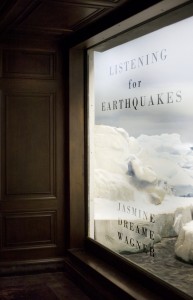Book Review
 Listening for Earthquakes by Jasmine Dreame Wagner was selected by Rosmarie Waldrop as the runner-up manuscript in the 2011 Caketrain Chapbook Competition . Before the five sections dividing—uniting—the book begin, Wagner opens with a single poem that signals the tone and themes to come. In this poem, “Black Swans,” verse appears in couplets composed of repetition and reformation.
Listening for Earthquakes by Jasmine Dreame Wagner was selected by Rosmarie Waldrop as the runner-up manuscript in the 2011 Caketrain Chapbook Competition . Before the five sections dividing—uniting—the book begin, Wagner opens with a single poem that signals the tone and themes to come. In this poem, “Black Swans,” verse appears in couplets composed of repetition and reformation.
It has been written, is written, will be written
That the first rule is that there are no rules; nothing is forbidden
All that has happened is happening now
All that will happen has happened
A quick flip through the book will confirm how Wagner does not, thankfully, follow rules. This poet is an interdisciplinary artist and so the visual presentation of Listening for Earthquakes is as delightful and varied as the content. Prose poems, formal verse, and free verse share the pages equally, as do experimental forms that stray from expectation.
The section “In Altitude,” for example, has a poem placed vertically on the page, rearranging the reader’s tactile experience and forcing a unique twist on the context of the poem: “There is no part of the body that hasn’t been pierced.” Might the line lengths of this poem fit on the page traditionally? Perhaps. Yet as the reader must turn the book sideways ninety degrees to the right in order to take in the poem, the nonconforming visual presentation heightens the verse:
the farther we live on into ourselves,
the farther we look back onto ourselves,
the harder we have to listen…
Further experimentation comes in the section “An Amusement Park Ride Gone Wrong,” where right justified text appears next to black and grey ink, again demonstrating Wagner’s artistic expression. This section’s poetic sequence comes to an end with poetry in columns, challenging the reader to choose her own adventure, so to speak, in reading horizontally left to right in a traditional pattern, or vertically, as three columns of text offer a more expected, seamless side-by-side narrative. Wagner challenges us not just to experience the poems, but to have fun throughout the process. As with the opening poem, “Black Swans,” the poet challenges us to break the rules and ignore what tradition urges.
In the final section, “Composition Retires,” a series of signature lines and black bars spread across five pages. Next to an “X” is the space reserved for the signatures accompanying “Ice in a Ziploc Bag” and “An Anorexic Sucks a Black Lozenge.” This particular sequence follows six pages of shaped, or concrete, poetry that plays across the page with a sparseness and balance that stands out against the white space.
Throughout Wagner’s collection there are subtle rhymes within lines and traditions buried in the poet’s innovative approach to verse. It is evident from the start that Wagner enjoys borrowing from and challenging tradition, as in the prose-like verse in the opening of the section, “Exhaust.” Here, as traveling narrators “drive to a place and perform for it,” human and animal come face to face where “Gazelles ignore us. Become contortionists. Consult thesauruses.” Wagner does not ignore the more formally recognized forms and figures; she embraces them, twists them, and challenges their use. This tactic again responds to the “Black Swans” opening, which displays Wagner’s masterful skill in bending and breaking the rules.
In the opening prose poem of the section “Where Memory Cracks,” the narrator furthers this playing-with-traditional-fire sensibility: “I know I shouldn’t shine a flashlight on the thorns / of raspberries, but I invest in a structure an ability to consider me / in return.” It is through the poet’s playfulness and interaction with “a structure” that her verse comes to life with musicality and dramatic verve, with the marriage of visual presentation and contextual imagery. It’s as though Wagner has applied all of her interdisciplinary prowess within this single collection.
Yet Listening for Earthquakes is not a song and dance production. Beyond the visual, behind the experimentation, there exists a challenging collection that combines explorations of natural and human behavior while bringing to the surface questions of self-consciousness. If Wagner’s approach earns attention for its cosmetic design, it is the genuine embrace of nature and landscape—and the human relationship to each—that will secure a dedicated attention span. The “Notes” section at the close of the collection reveals the factual people, places, and events that inspired her verse, including, “The Great Dismal Swamp, a vast wetland area on the North Carolina/Virginia border” known for its vegetation, refuge for escaped slaves, and eventual home for a military training facility.
In her playful presentation, Wagner invites the individual to enter the natural world and come out refreshed, revived, and more in tune with one’s self—in whatever form, whatever level of transformation that means to each person. In sharing her own poetic and visual reflections, the poet extends the invitation to break the rules, go against the grain, and allow the self to witness and respond in whatever way comes most natural, as in “Champion Mill”:
go to a field with a friend
pass caricature paintings
past weed acrylic flint
and lay on your back arms spread
and lay in the black stink of park
earth convex against your harp
dirt flexed under mars
About the Reviewer
Lori A. May writes across the genres and reviews for publications including Los Angeles Review and New Orleans Review. Her writing has appeared in Hippocampus Magazine, Phoebe, and elsewhere. A Canadian expat, she now lives in Michigan and online at www.loriamay.com.